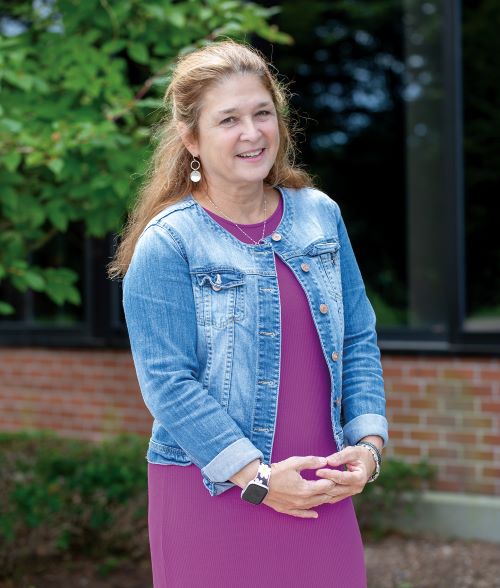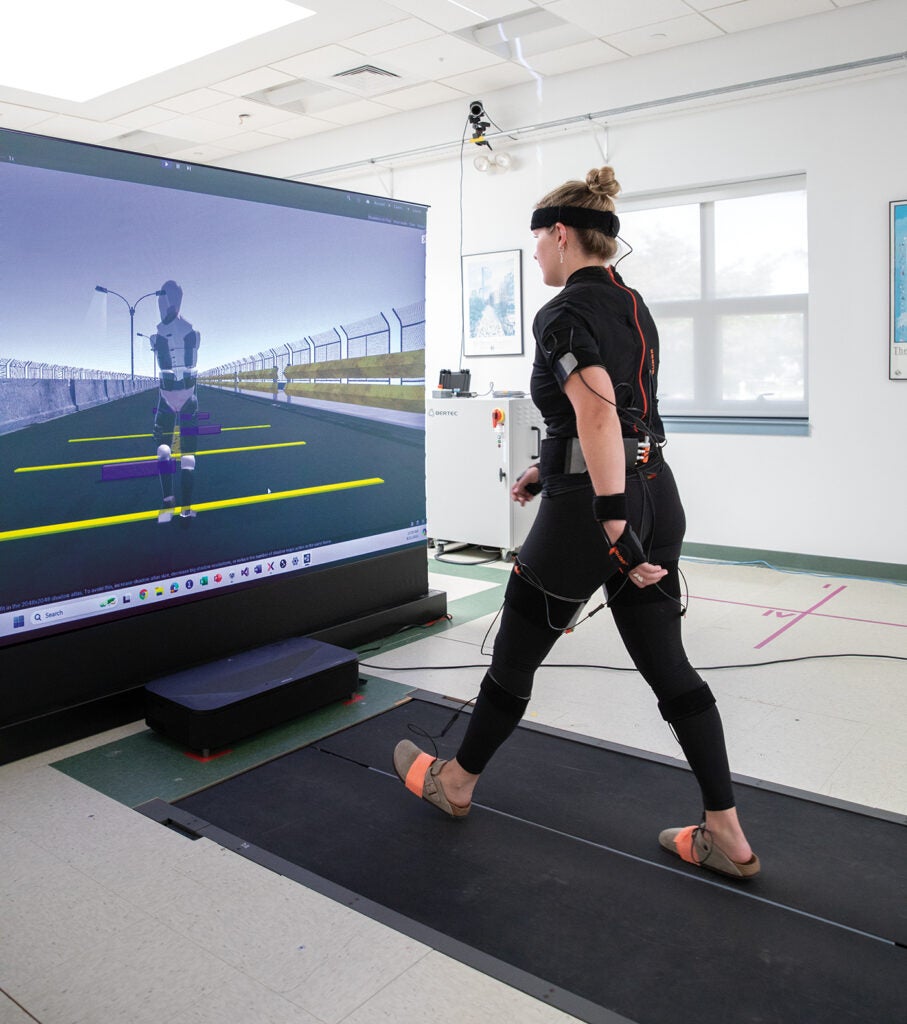Research in Motion
Written by Allison Farrelly ’16
Photos by Beau Jones

Assistant Professor of Kinesiology and Biomedical Engineering
Ryan Research Assistant Professor of Neuroscience
While University of Rhode Island (URI) Assistant Professor Susan D’Andrea’s background is in engineering, her focus is on human movement. And she’s combining her disciplines to develop games that can help stoke patients walk better and amputees use their prosthetics better, among many other applications.
“I wanted to use my engineering skills to work with people and help improve their function in everyday life,” says D’Andrea who holds appointments in kinesiology, biomedical engineering and is a Ryan research assistant professor of neuroscience. “My overall research goal is to develop therapies for patients with movement disabilities that can be done at home to augment the work done with a physical therapist.”
While traditional physical therapy for movement disabilities involves hands-on work in a clinic and a worksheet of self-guided, at-home exercises, D’Andrea is hoping to up patients’ progress by gamifying it with virtual reality.
“When you play a game, you are driven to get a good score and boost your score with each new attempt,” she explains. “We have designed virtual reality games for rehabilitation that have different difficulty levels that motivate the patient to progress through the levels and continue the therapy which will ultimately improve their function.”
ALL ABOUT THE EQUIPMENT

URI’s biomechanics lab is uniquely equipped for a researcher with questions like D’Andrea’s. D’Andrea uses a host of high- tech equipment to map human movement and to identify patterns and develop targeted therapies.
“Using the equipment in the lab, I can understand if people are moving incorrectly and why they’re moving incorrectly and come up with ways to improve their movement patterns,” she says.
A motion capture system allows D’Andrea to use reflective markers placed on the body to map the motions of someone. She then uses these digital markers to create a digital skeletal map of the person and analyze the angles and forces of joints from the ankle, knee or hip joints to the whole-body system.
To understand how muscles are working, she often uses electromyography system (EMG) that measures muscle activity during movement. She also uses an inertial suit, fitted with inertial sensors that can be put on different parts of the body, to monitor motion.
To bring her therapies to life, she takes advantage of virtual and augmented reality systems she has designed.
RESEARCH IN MOTION
D’Andrea has spent the past two years developing virtual reality games that help stroke patients improve their walking. Funded by a $25,000 grant from the Rhode Island Foundation, D’Andrea had five study participants walk on a treadmill in front of a large screen while wearing an inertial suit that recorded information on how their arms, legs, heads, and torso were moving. The screen featured a virtual environment with an avatar, controlled by the person’s movement, and virtual obstacles for the avatar to step over, around or on.
After an intensive intervention of 10 sessions over two weeks, D’Andrea and her team saw “very, very promising results” compared to the baseline measurements taken of patients’ balance and walking abilities.
“Our participants improved their walking abilities significantly. Each person was able to achieve a clinically significant improvement. This has implications in their everyday life, their actual function and ability to walk.”Susan D’Andrea
In addition to walking, D’Andrea is also developing upper extremity therapies for stroke patients. One project leverages carnival-themed computer games developed by D’Andrea and a team of students she mentors in the biomedical engineering senior capstone course. The project engages stroke patients in exercising their elbow, wrist, and shoulder while wearing an inertial suit to track movements and drive the motion of an avatar in the virtual environment. Another group of her capstone students helped create an augmented reality game to train amputees to develop more control of their prosthetics and prevent prosthetic rejection.
The game features a visor that projects a pyramid of six holographic cups that need to be stacked in different orders with an upper extremity prosthesis. They’re still testing the game with a bypass prosthetic—designed to stimulate a prosthetic for people with arms—with plans to expand the trial to amputees soon.
Ultimately, D’Andrea and her team hope to develop the games they are working on into therapies for patients to use at home. Current devices for home augmented and virtual reality, like the Microsoft HoloLens and the Apple Vision Pro, come at a prohibitive price point, but D’Andrea has hopes this won’t always be the case. In the meantime, she’s perfecting her methods and exploring alternatives like phone apps.
“We’re showing that virtual and augmented reality work for rehabilitation. They’re effective, motivating and engaging for patients to use,”
she says.
D’Andrea started her career at Florida’s Miami Children’s Hospital, working with children with cerebral palsy in in a clinical motion analysis lab. She went on to hold appointments at Ohio State University, the Cleveland Clinic and Brown University. Most recently, she spent 10 years at the Providence VA Medical Center in Rhode Island, developing therapies to help amputees use their prosthetics more effectively. She’s found URI to be a prime place to be for this phase of her career.
“It’s nice to be able to work directly with students,” she says. “I love to teach and engage students in research. And it’s very satisfying to see when the light bulb goes off and I know the students really understand what we are trying to do.”
